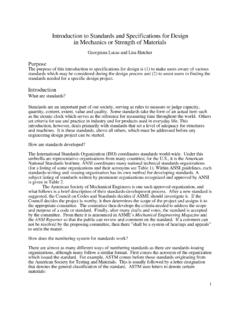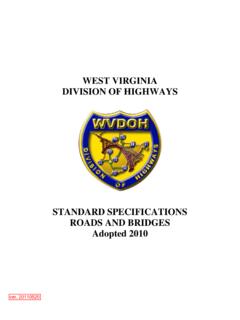Transcription of Advisory Circular - Federal Aviation Administration
1 Advisory Circular Subject: Guide for Developing a Receiving Inspection System for Aircraft Parts and Material Date: 12/12/05 Initiated by: AFS-300 AC No: 20-154 1. PURPOSE. This Advisory Circular (AC) provides guidance and information for incorporation into operators existing receiving/inspection systems to help prevent the introduction of unairworthy parts into inventories. The aim is to establish sufficient traceability to establish that the part(s) were manufactured under Title 14 of the Code of Federal Regulations (14 CFR) part 21, were previously determined to be airworthy under 14 CFR part 43, produced to established industry or Government standards or accepted foreign standards .
2 Like all AC material, this AC is not mandatory and does not constitute a regulation. It is issued for guidance and to outline a method of compliance with the rules. This is one means but not the only means for developing a receiving inspection system. In lieu of following the method(s) prescribed herein, the applicant may elect to follow an alternate method. 2. APPLICATION. These elements are recommended for incorporation into operators existing receiving/inspection systems to help prevent the introduction of unairworthy parts into inventories. The aim is to establish sufficient traceability to establish that the part(s) were manufactured under part 21, were previously determined to be airworthy under part 43, and produced to established industry or Government standards or accepted foreign standards .
3 3. REGULATIONS AND GUIDANCE MATERIAL. a. Related 14 CFR Parts Include: (1) Part 1, Definitions and abbreviations. (2) Part 21, Certification procedures for products and parts. (3) Part 43, Maintenance, preventive maintenance, rebuilding, and alteration. (4) Part 45, Identification and registration marking. (5) Title 49, Other regulations relating to transportation. b. Related Guidance Materials Include (current editions): (1) AC 00-56, Voluntary Industry Distributor Accreditation Program. AC 20-154 12/12/05 (2) AC 20-62, Eligibility, Quality, and Identification of Aeronautical Replacement Parts.
4 (3) AC 21-20, Supplier Surveillance Procedures. (4) AC 21-29, Detecting and Reporting Suspected Unapproved Parts. (5) AC 43-9, Maintenance Records. (6) AC 45-2, Identification and Registration Marking. (7) AC 145-7, Issuance of Repair Station Certificates to Foreign-Approved Maintenance Organizations Under the Maintenance Implementation Procedures of a Bilateral Aviation Safety Agreement. (8) AC 145-9, Guide for Developing and Evaluating Repair Station and Quality Control Manuals. (9) Federal Aviation Administration (FAA) Order , Disposition of Scrap or Salvageable Aircraft Parts and Materials.
5 (10) FAA Order , Airworthiness Certification of Aircraft and Related Products. (11) FAA Order , Procedures for Completion and Use of the Authorized Release Certificate, FAA Form 8130-3, Airworthiness Approval Tag. NOTE: Interested persons can access ACs and orders on the FAA home page at and selecting Regulations and Policies then selecting the link for Advisory Circulars or Orders, or at Copies of FAA ACs and orders also can be obtained free of charge from the Department of Transportation, Subsequent Distribution Office, Ardmore East Business Center, 3341 Q. 75th Ave., Landover, MD 20785.
6 4. BACKGROUND. The FAA has expressed ongoing concern that unairworthy appliances, components, or parts thereof, as well as materials, are being installed on type-certificated products. Therefore, the FAA recommends that parts installers, maintainers, manufacturers, or suppliers establish an enhanced receiving inspection system to help eliminate the safety risk posed by unairworthy components, parts, or materials. A comprehensive network of regulatory controls governs the design, manufacture, installation, and maintenance of aircraft parts. However, whether by inadvertent or deliberate action, components or parts have been reported that do not meet regulatory requirements and are not eligible for installation.
7 Maintenance providers should have a procedure describing their processes for procuring, receiving, and inspecting aircraft components, parts, and materials. These procedures will ensure conformity to the type design or specifications to ensure that the product being returned to service conforms to specified airworthiness requirements and is in a condition for safe operation. Page 2 Par 3 12/12/05 AC 20-154 5.
8 DEFINITIONS. a. Airworthy. (1) The aircraft must conform to its type certificate (TC). Conformity to type design is considered attained when the aircraft configuration and the components installed are consistent with the drawings, specifications, and other data that are part of the TC, which includes any Supplemental Type Certificates (STC) and field-approved alterations incorporated into the aircraft. (2) The aircraft must be in a condition for safe operation. This refers to the condition of the aircraft relative to wear and deterioration, for example, skin corrosion, window delamination/crazing, fluid leaks, and tire wear, etc.
9 B. Approved Part. A part or part thereof that was designed, fabricated, produced, and/or maintained under the appropriate regulation. This could include the following: (1) Produced in accordance with a Parts Manufacturer Approval (PMA) issued under part 21, subpart K. (2) Produced in accordance with a Technical Standard Order Authorization (TSOA) issued under part 21, subpart O. (3) Produced during the TC application process under part 21, subpart B, or the STC application process under part 21, subpart E, prior to the issuance of the certificate; subsequently determined to conform to the approved TC or STC data (refer to part 21, section (b)(1)).
10 (4) Produced under a TC without a separate production authorization, and an Approved Production Inspection System (APIS), in accordance with part 21, subpart F. (5) Produced under a Production Certificate (PC) (including production by a licensee if produced under PC authority), in accordance with part 21, subpart G. NOTE: A licensee is a person who has exclusive or nonexclusive rights to apply for a PC (refer to part 21, section (a)(2)) under licensing agreement, if they hold or have been awarded rights to the benefit of a TC holder from the owner of the TC. The term licensing agreement does not imply or infer that a PC holder may grant production approval to any party on behalf of the FAA.

















